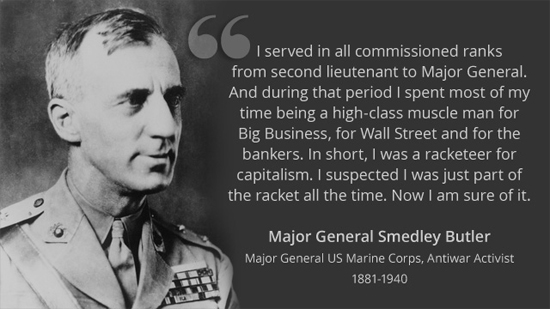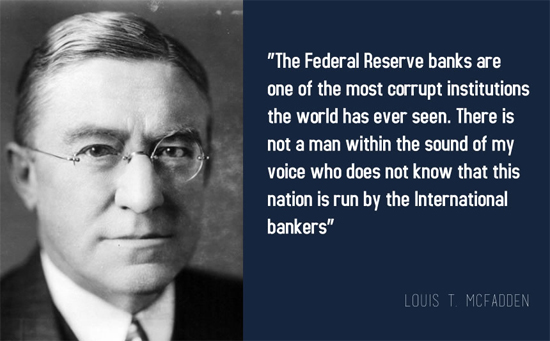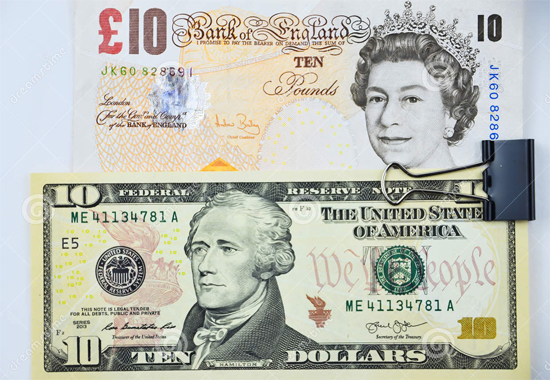All Wars Are Bankers Wars! (4)
Read the third part of the article
Smedley Butler
As a side note, we need to step back before WW2 and recall Marine Major General Smedley Butler. In 1933, Wall Street bankers and financiers had bankrolled the successful coups by both Hitler and Mussolini. Brown Brothers Harriman in New York was financing Hitler right up to the day war was declared with Germany.

Albert Einstein was of the opinion that the late entry of the US into the war against Germany was because the US was controlled by bankers who were making money off of Hitler.
The Wall Street bankers decided that a fascist dictatorship in the United States based on the one on Italy would be far better for their business interests than Roosevelt’s “New Dealˮ which threatened massive wealth re-distribution to recapitalize the working and middle class of America. So the Wall Street tycoons recruited General Butler to lead the overthrow of the US Government and install a “Secretary of General Affairsˮ who would be answerable to Wall Street and not the people, would crush social unrest and shut down all labor unions.
General Butler pretended to go along with the scheme but then exposed the plot to Congress. Congress, then as now in the pocket of the Wall Street bankers, refused to act.
When Roosevelt learned of the planned coup he demanded the arrest of the plotters, but the plotters simply reminded Roosevelt that if any one of them were sent to prison, their friends on Wall Street would deliberately collapse the still-fragile economy and blame Roosevelt for it.
Roosevelt was thus unable to act until the start of WW2, at which time he prosecuted many of the plotters under the Trading With The Enemy act. The Congressional minutes into the coup were finally declassified in 1967, but rumors of the attempted coup became the inspiration for the movie, “Seven Days in Mayˮ but with the true financial villains erased from the script.
“I spent 33 years and four months in active military service as a member of our country’s most agile military force, the Marine Corps. I served in all commissioned ranks from second lieutenant to Major General. And during that period I spent more of my time being a high-class muscle man for Big Business, for Wall Street and for the bankers. In short, I was a racketeer, a gangster for capitalism.
I suspected I was just a part of a racket at the time. Now I am sure of it. Like all members of the military profession I never had an original thought until I left the service.
My mental faculties remained in suspended animation while I obeyed the orders of the higher-ups. This is typical with everyone in the military service. Thus I helped make Mexico and especially Tampico safe for American oil interests in 1914.
I helped make Haiti and Cuba a decent place for the National City Bank boys to collect revenues in. I helped in the raping of half a dozen Central American republics for the benefit of Wall Street.
The record of racketeering is long. I helped purify Nicaragua for the international banking house of Brown Brothers in 1909-12. I brought light to the Dominican Republic for American sugar interests in 1916.
In China in 1927 I helped see to it that the Standard Oil went its way unmolested. During those years, I had, as the boys in the back room would say, a swell racket. I was rewarded with honors, medals and promotion.
Looking back on it, I feel I might have given Al Capone a few hints. The best he could do was to operate his racket in three city districts. I operated on three continents.ˮ – General Smedley Butler, former US Marine Corps Commandant, 1935
Louis T. McFadden

Louis T. McFadden was a member of the House of Representatives in the twenties and thirties. He was the chair of the House Banking and Currency Committee during the twenties. He used his position in Congress occasionally to crusade against the Federal Reserve.
“Mr. Chairman, we have in this country one of the most corrupt institutions the world has ever known. I refer to the Federal Reserve Board and the Federal Reserve banks.
The Federal Reserve Board, a Government board, has cheated the Government of the United States out of enough money to pay the national debt. The depredations and the iniquities of the Federal Reserve Board and the Federal reserve banks acting together have cost this country enough money to pay the national debt several times over.
This evil institution has impoverished and ruined the people of the United States; has bankrupted itself, and has practically bankrupted our Government. It has done this through defects of the law under which it operates, through the maladministration of that law by the Federal Reserve Board and through the corrupt practices of the moneyed vultures who control it.ˮ – Louis T. McFadden, June 10, 1932
At one point McFadden started impeachment proceedings against the entire board of the Federal Reserve. Not too surprisingly, there were three attempts on McFadden’s life, one shooting and two poisonings, the second of which was successful.
Although still officially declared as heart failure, newspapers of the time reported:
“Now that this sterling American patriot has made the Passing, it can be revealed that not long after his public utterance against the encroaching powers of Judah, it became known among his intimates that he had suffered two attacks against his life.
The first attack came in the form of two revolver shots fired at him from ambush as he was alighting from a cab in front of one of the Capital hotels. Fortunately both shots missed him, the bullets burying themselves in the structure of the cab.ˮ
“He became violently ill after partaking of food at a political banquet at Washington. His life was only saved from what was subsequently announced as a poisoning by the presence of a physician friend at the banquet, who at once procured a stomach pump and subjected the Congressman to emergency treatment.ˮ
President John F. Kennedy
As President, John F. Kennedy understood the predatory nature of private central banking. He understood why Andrew Jackson fought so hard to end the Second Bank of the United States. So Kennedy wrote and signed Executive Order 11110 which ordered the US Treasury to issue a new public currency, the United States Note.
Kennedy’s United States Notes were not borrowed from the Federal Reserve but created by the US Government and backed by the silver stockpiles held by the US Government.
It represented a return to the system of economics the United States had been founded on, and was perfectly legal for Kennedy to do. All told, some four and one half billion dollars went into public circulation, eroding interest payments to the Federal Reserve and loosening their control over the nation.
Five months later John F. Kennedy was assassinated in Dallas Texas, and the United States Notes pulled from circulation and destroyed (except for samples held by collectors).
John J. McCloy, President of the Chase Manhattan Bank, and President of the World Bank, was named to the Warren Commission, presumably to make certain the banking dimensions behind the assassination were concealed from the public.
Kennedy’s E.O. 11110 has never been repealed and is still in effect, although no modern President dares to use it. Almost all of the current national debt has been created since 1963.
As we enter the eleventh year of what future history will most certainly describe as World War Three, we need to examine the financial dimensions behind the wars.
Towards the end of World War Two, when it became obvious that the allies were going to win and dictate the post war environment, the major world economic powers met at Bretton Woods, a luxury resort in New Hampshire in July of 1944, and hammered out the Bretton Woods agreement for international finance.
The British Pound lost its position as the global trade and reserve currency to the US dollar (part of the price demanded by Roosevelt in exchange for the US entry into the war).

Absent the economic advantages of being the world’s “go-toˮ currency, Britain was forced to nationalize the Bank of England in 1946. The Bretton Woods agreement, ratified in 1945, in addition to making the dollar the global reserve and trade currency, obligated the signatory nations to tie their currencies to the dollar.
The nations that ratified Bretton Woods did so on two conditions. The first was that the Federal Reserve would refrain from over-printing the dollar as a means to loot real products and produce from other nations in exchange for ink and paper; basically an imperial tax. That assurance was backed up by the second requirement, which was that the US dollar would always be convertible to gold at $35 per ounce.
The Federal Reserve, being a private bank and not answerable to the US Government, did start overprinting paper dollars, and much of the perceived prosperity of the 1950s and 1960s was the result of foreign nations’ obligations to accept the paper notes as being worth gold at the rate of $35 an ounce.
Then in 1970, France looked at the huge pile of paper notes sitting in their vaults, for which real French products like wine and cheese had been traded, and notified the United States government that they would exercise their option under Bretton Woods to return the paper notes for gold at the $35 per ounce exchange rate.
The United States had nowhere near the gold to redeem the paper notes. By 1966, the IMF estimated foreign central banks held $14 billion U.S. dollars, however the United States had only $3.2 billion in gold to redeem those paper notes! So on August 15th, 1971, Richard Nixon “temporarilyˮ suspended the gold convertibility of the US Federal Reserve Notes.
Later termed the “Nixon shockˮ, this move effectively ended Bretton Woods and many global currencies started to delink from the US dollar.
Worse, since the United States had collateralized their loans with the nation’s gold reserves, it quickly became apparent that the US Government did not in fact have enough gold to cover the outstanding debts.
Foreign nations began to get very nervous about their loans to the US and understandably were reluctant to loan any additional money to the United States without some form of collateral. So Richard Nixon started the environmental movement, with the EPA and its various programs such as “wilderness zonesˮ, “roadless areasˮ, “heritage riversˮ, “wetlandsˮ, all of which took vast areas of public lands and made them off limits to the American people who were technically the owners of those lands.
But Nixon had little concern for the environment and the real purpose of this land grab under the guise of the environment was to pledge those pristine lands and their vast mineral resources as collateral on the national debt.
The plethora of different programs was simply to conceal the true scale of how much American land was being pledged to foreign lenders as collateral on the government’s debts; eventually almost 25% of the nation itself. All of this is illegal as the Enclave Clause of the Constitution limits the Federal Government to owning the land under Federal Government buildings and military bases, and that Enclave Clause was written into the Constitution by the Founding Fathers specifically to prevent the Federal Government simply seizing the land belonging to the people to sell off, pledge as collateral, or rent!
With open lands for collateral already in short supply, the US Government embarked on a new program to shore up sagging international demand for the dollar.
The United States approached the world’s oil producing nations, mostly in the Middle East, and offered them a deal. In exchange for only selling their oil for dollars, the United States would guarantee the military safety of those oil-rich nations.
The oil rich nations would agree to spend and invest their US paper dollars inside the United States, in particular in US Treasury Bonds, redeemable through the slave labor of future generations of US taxpayers.
The concept was labeled the “petrodollarˮ. In effect, the US, no longer able to back the dollar with gold, was now backing it with oil. Other peoples’ oil. And that necessity to keep control over those oil nations to prop up the dollar has shaped America’s foreign policy in the region ever since.
But as America’s manufacturing and agriculture has declined, the oil producing nations faced a dilemma. Those piles of US Federal Reserve notes were not able to purchase much from the United States because the United States had little (other than real estate) anyone wanted to buy.
Europe’s cars and aircraft were superior and less costly, while experiments with GMO food crops led to nations refusing to buy US food exports. Israel’s constant belligerence against its neighbors caused them to wonder if the US could actually keep their end of the petrodollar arrangement. Oil producing nations started to talk of selling their oil for whatever currency the purchasers chose to use.
Read the fifth part of the article
yogaesoteric
February 26, 2018
